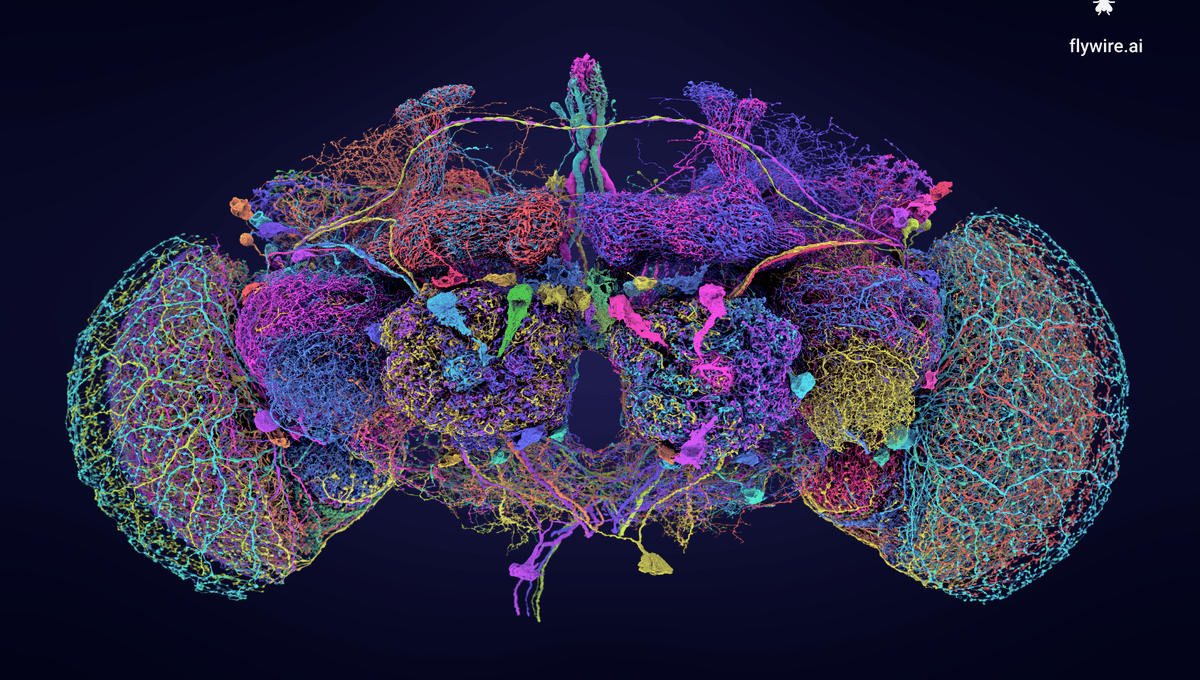
In a feat that seemed unachievable just a few short years ago, an international research consortium has today unveiled the first complete wiring diagram of an entire fruit fly brain. The map itself is accompanied by a cache of papers, demonstrating how this breakthrough is already leading to new scientific findings – and there’s much more to come.
Why do we need brain maps anyway?
Maps that show every neuron in a brain and all the myriad connections between them are called connectomes. The first organism to be mapped in this way was the worm Caenorhabditis elegans, after its nervous system was described in its entirety in a seminal paper back in 1986. The work shaped the future of research into C. elegans – one of our most widely used model organisms – and its impact can still be felt to this day.
But C. elegans doesn’t actually have a brain. At least, not one that we would recognize. It manages to do some pretty cool stuff with only a “nerve ring”, even demonstrating some basic learning, but you need to look elsewhere if you want to even start to approach the complexity of the human brain.
That’s where Drosophila melanogaster comes in. The fruit fly is one of the most useful model organisms in neuroscience.
“Flies can do all kinds of complicated things like walk, fly, navigate, and the males sing to the females,” explained Dr Gregory Jefferis of the University of Cambridge, one of the co-leaders of the new research, in a statement. They can achieve all this thanks to the 139,255 neurons in their brains, connected by over 50 million synapses.
“If we want to understand how the brain works, we need a mechanistic understanding of how all the neurons fit together and let you think,” continued Jefferis. “For most brains we have no idea how these networks function.”
That’s why many scientists have gotten behind the field of connectomics, and recognize the value of mapping a brain to this level.
How did we get here?
The FlyWire Consortium was launched as a way to leverage the latest technology and bring together expertise from dozens of labs around the world, with the aim of producing a full connectome of the fruit fly brain. But the task they faced was daunting. “Only a few years ago, obtaining a complete Drosophila connectome seemed out of reach,” writes Anita V. Devineni in a News & Views piece accompanying the new published papers.
C. elegans contains just 302 neurons. Scientists had also previously mapped a larval fruit fly brain, which contains about 3,000. But for an adult fruit fly, they would have to scale that up to close to 140,000 – and even that is still dwarfed by the human brain, which is thought to contain more like 80 billion.
The map began with 21 million images of an adult female (we love to see it) fruit fly brain. With the help of artificial intelligence (AI), the images were aligned and 3D reconstructions of individual neurons generated. This “first draft” then had to be painstakingly proofread, so the consortium enlisted the help of hundreds of researchers and citizen scientists from around the world – it’s estimated that for a single person to do this work full time, it would have taken a whopping 33 years.
“In 2021, only 15 percent of the neurons had been proofread,” said Dr Shelli Avenevoli in another statement, so it’s amazing to think how much progress has been made in only three years.
Other existing data was leveraged to then identify and categorize the synapses – all 50 million of them! – and then came the task of “reading” the map. In one of the papers, Jefferis, together with the University of Vermont’s Davi Bock and other colleagues, annotate the different types of neurons that can be found within the brain. There’s a total of more than 8,400, of which over 4,500 are brand new to science.
With some of the 3D animations generated in the different research projects, we can get a glimpse deep inside different sections of the brain. Here, you can soar into the fly’s auditory neurons, the cells the female uses to detect the songs of potential mates.
And here, you can zoom around part of the fly’s internal compass, called the EPG ring.
This CT1 neuron is one of only two, each spanning an entire eye and containing over 140,000 synapses.
Where do we go from here?
This is an incredible breakthrough, but if you’re hoping to see something similar for the human brain you’re probably going to have to wait some time. A whole fly brain is less than 1 millimeter wide; a whole human brain is almost unfathomably more complex.
The team does have another goal in mind already, however. “The fly brain is a milestone on our way to reconstructing a wiring diagram of a whole mouse brain,” commented Dr Sebastian Seung of Princeton University, one of the research co-leads.
Now that FlyWire has shown what can be achieved, there’s no reason the same approach can’t be gradually scaled up to tackle bigger challenges. And in the meantime, the connectome is already facilitating research that could have important implications for humans too. “Years of work spent on anatomical experiments to trace connectivity will be replaced by a few clicks on the FlyWire website,” Devineni writes.
Flies share 60 percent of our DNA, and there are many parallels in how our brains work. The publication of this new brain map marks a true milestone moment that will doubtless shape neuroscience research for decades to come.
The flagship paper is published in Nature. The companion papers, also published in Nature, can be accessed via this landing page.
Source Link: World’s First “Google Maps” For An Entire Brain Is Here, And You Can Zoom Inside